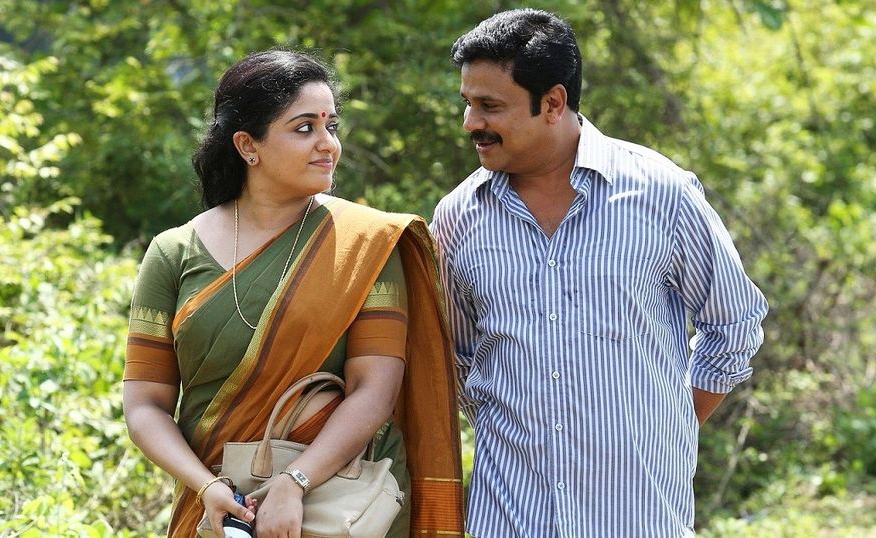
Dileep and Kavya Madhavan in Pinneyum
I have a new accomplishment – of having watched an Adoor Gopalakrishnan film in Mumbai on its release weekend. The show almost saw a full house as the film features an onscreen pair rooted by the masses – Dileep and Kavya Madhavan. Sounds surreal, but this is real. Pinneyum marks Adoor Gopalakrishnan’s return to filmdom after a break of 8 years.
A classic, dramatic narrative is known to be the veteran director’s hallmark. His characters always spoke chaste Malayalam, with non-colloquial words and idioms appearing often. Can hiring a popular pair change what probably runs in the filmmaker’s bloodline? Not quite.
The premise
Pinneyum starts with an interrogation of a suspected suicide. Not much are we informed about this incident and the film cuts to the main story. There is a jump in timeline here and we learn this quite late in the day. The male lead Purushothaman Nair (Dileep) is soon introduced as a family man who is unemployed for 8 years long years after passing his B.Com course. Not that he didn’t apply for jobs, he didn’t just crack any. Isn’t this a not-so-obvious dig on our reservation system? Also to be noted is Nair’s father-in-law (who belongs to the higher Nair sub caste, Pillai) repeatedly addressing him by his full name. Heavily dramatized scenes continue in full throttle with one involving an interview panel taking it too far. As the film progresses, we are introduced to more interesting characters and the dramatic tone subsides, the dialogues get better. We get to see the embittered Devi (Kavya Madhavan), her hapless yet content elder brother Kuttan (Indrans) and more. The jobless Nair is soon hired for a good post in a Middle Eastern company. At this juncture, narrative style temporarily switches to a semi-poetic one.
As noted earlier, we aren’t told about the decade Pinneyum is set in. There are letters being exchanged, there’s a postman asking for his share upon bringing a good news, there are Ambassador and Premier Padmini cars and there is no trace of cell phones (or even land phones, for that matter). Though the vehicle registrations tell a different story, it seems like a story set in the late 90s. Time takes a massive jump in the second half, thus proving us right. More of that later…
The twist and the subtexts
Well, a mind-boggling twist arrives at the interview point. It is hard to digest, very hard – since it comes totally out of context. Plus, there is no spook, almost no emergency in the way this episode is written and executed. If one could come to terms with it, the rest of Pinneyum will be a smooth ride. Adoor makes several attempts (some good, some bad) to convince us of this drastic turn that exposes our protagonist’s criminal mind. In a rather mindless scene, Nair steps out to the village library wielding a book by Agatha Christie. His father-in-law, a retired teacher, is also familiar with the author. In this scene which only means to justify the upcoming turn, Nair holds a paperback edition that is too pretty for a public library and also for the era (just saying!). Adoor, the writer, also gives us a roadside dweller who shows different colours in the daylight and the wee hours. Pillai makes a retort in an attempt to save their conscience. This subtext does work, to an extent. There’s another scene involving Pillai whose financially well-to-do relative turns up with a request. All of a sudden, the family gets a taste of power – of wealth, of social status. We also see Nair being too generous a person. He donates a huge sum to the temple fund. He is an underdog, repressed and ridiculed for a decade. Out there in the Middle East, he must have met 20-somethings minting money like he could never think of. How to salvage the lost years? Hard work is not an option if you are ageing and/or have read Agatha Christie. Devi’s role in this whole game changer of a segment is mostly conspicuous by its absence.
Post-interval, the film shifts genres and gets dangerously close to be a crime thriller – only to reach a screeching halt in a matter of few minutes. An event that is straight lift from the life and disappearance of notorious criminal Sukumara Kurup, we are puzzled to believe the proceedings or not. While Adoor offers us no explanations on the Jupiter-sized loopholes out there, the fact that the actual criminal has never been traced is chilling enough to buy the story. Interestingly, Kurup also belonged to the Nair community and his is Kerala’s most intriguing, unsolved crime story of all times. In Pinneyum, Adoor also employs hearsay about Kurup’s reappearance. There is feeble mention of one of the characters being a diamond merchant.
Devi, redemption and the finale
Soon, the film and the characters begin to tread an emotional journey. This is where Devi takes over. Kavya Madhavan’s face poignantly reflects her internal commotion. There is loneliness, agony, regret and elusive hope. Holding back truth from her loving brother and daughter, Devi hasn’t smiled for ages. Kavya lends such fantastic touches – even with that waiver in her voice and an idle body language. Blessed with an evocative voice, Kavya wasted a decade in her career hiring a dubbing artiste who couldn’t match her emoting prowess. Cinema and stereotypes, I tell you. There is also this lovely sub-story of an already burdened Devi helping a poor child pursue college – because she is obliged to, like no one else is. Painful.
Devi, in all possibilities, is going to be Kavya’s most rewarded performance till date. Towards the later reels, comes another twist which isn’t as shocking as the one earlier but is eerier than previous week’s horror flick Pretham. In a rather well-written and enacted episode, actors (Madhavan and Marathi actor Subodh Bhave) take full use of the opportunity leading to an apt conclusion.
The efficient crew
Adoor Gopalakrishan knows his technicians. His catchphrase might be minimal but high on impact. Cinematography by M. J. Radhakrishnan is one of the best in recent times. Night shots in Pinneyum look cinematic yet very real. Together with the editor (B. Ajith Kumar) and sound designer (N. Harikumar), Adoor and Radhakrishnan weave sheer beauty – notably in a delicate romantic sequence once the lead player leaves to the middle-east. The is a particularly long scene where Devi puts her daughter to sleep, walks around the room to switch off lights. We are quietly familiarized with the rooms’ structure, especially the window’s position. A window that is instrumental in leading us to the finale.
Bijibal’s background score has the redolence of a holy basil plant. The film sets off with the signature tune strummed on Veena. Several instruments play it throughout the film – the flute being prominent. The veena strain returns as the end credits roll. Haunting work that heightens the tension on screen.
What doesn’t work?
While the main twist doesn’t completely work, there are others that fall flat – one is that of Nair’s sister and her negligent husband. Marred by a bland performance by the otherwise dependent Srinda, this subplot culminates vaguely. The otherwise miserable sister turns all gleeful in the end. Of course, we are told about a rumoured ‘benefactor’ who changes their lives. Ahem! Too far-fetched a thought to even consider buying. Furthermore, for a film pitched as a love story, love is one thing that clearly doesn’t get much scope in Pinneyum. The film is more of a statement how dwindling morals, greed and naivety can destroy a reasonably happy family.
Affecting performances
When entrusted with an offbeat character, Dileep is known to do quite well. Kathavasheshan was an impressive attempt. While Arike remains one of the best love stories Malayalam cinema has produced, Dileep’s approach could have been different. In Pinneyum, the actor is a complete revelation as Nair. Omnipresent in the narrative, at times only with his voice, he lends maturity and a studied poise to Nair.
As the film’s conscience, Indrans is gifted with (easily) the best written role in the enterprise. The actor’s composed performance is a delight. That too in a role that could have been trivialized in hands of a lesser actor. Genius!
Subodh Bhave is excellent. While Nedumudi Venu does well as Pillai, one wonders why Vijayaraghavan is forever entrusted with unlayered, one-note characters. Srinda disappoints and so does Meera Nallur. Akshara Kishore is good as the school-going daughter. Vishakh makes an impressive debut.
Is Pinneyum worth your time?
Pinneyum is not the regular Dileep-Kavya potboiler. Yes, there is a noticeable lack of attention to detail in Adoor’s usually faultless screenplay. While succeeding as a director, he doesn’t try a midway route given the presence of stars – there is no song to hum along even. Still, the film makes sure to keep you on tenterhooks. Pinneyum is the kind of film you would watch years later and discover new layers, new connotations, and more of its thoughtfully captured shots. Off to the DVD release now.
Rating: ★★★ 1/2
Watch Pinneyum‘s trailer HERE!

